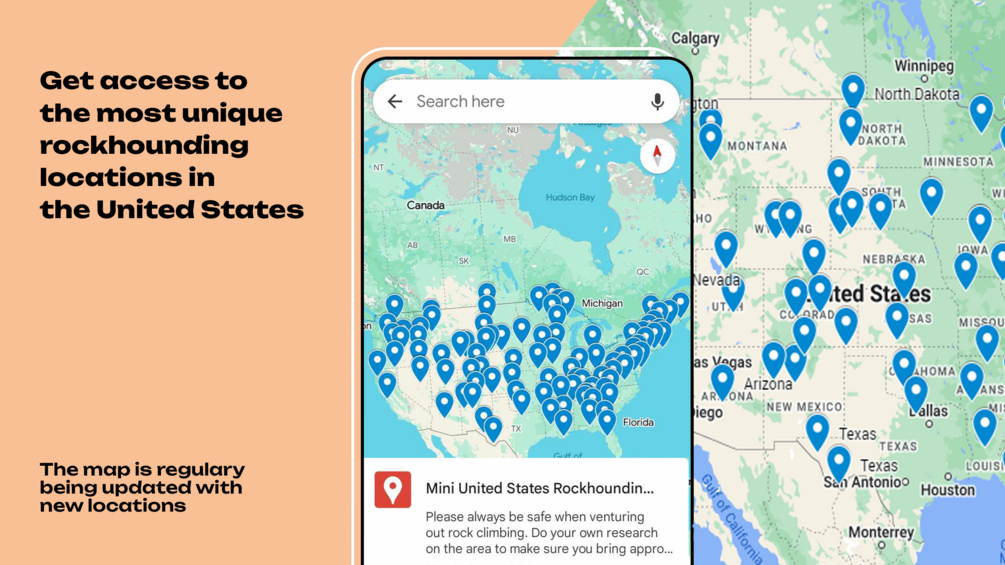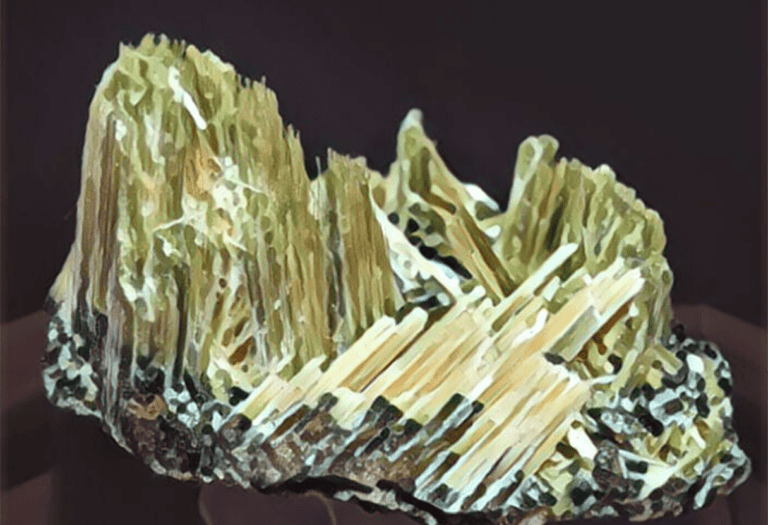Ever wondered what treasures are hidden beneath Kentucky’s rolling hills and lush landscapes?
You’re in for a treat! Rockhounding in the Bluegrass State is a thrilling adventure, with a trove of geological wonders waiting to be discovered.
From the world-famous geodes of the Green River to the fossil-rich beds of the Ohio River Valley, Kentucky offers a diverse array of locales for both amateur and seasoned rockhounds.
You’ll find a variety of minerals, fossils, and crystals that reflect the state’s unique geological history.
Kentucky offers a variety of rockhounding opportunities, from quartz and fluorite at Land Between the Lakes to fossils at Falls of the Ohio State Park. Key finds include agate, freshwater pearls, sapphires, quartz, and geodes. Respect local regulations and private property rights for a rewarding rockhounding experience.
Get our FREE United States Rockhounding Map HERE

Kentucky Rockhounding Locations
Embarking on a rockhounding excursion in Kentucky offers a thrilling chance to uncover a variety of geological marvels. Kentucky is replete with locations that cater to the avid rockhound. Below, you’ll encounter prime spots that are rich with geological potential.
Land Between the Lakes is a haven for rockhounders looking for quartz and fluorite. The vast array of mineral deposits in this area makes it a can’t-miss destination. You’ll find yourself surrounded by natural beauty as you search for these valuable rocks.
Move south and you’ll stumble upon the Cumberland Gap region, known for its historical significance and diverse collectibles. Here, you can find breathtaking crystals and calcite formations, perfect for both novice and seasoned collectors.
Solo adventurers or family explorers can head to the Ben E. Clement Mineral Museum in Marion. This spot not only allows for discovering mineral specimens but also offers educational trips where you can learn about the region’s mining history.
For those fascinated by ancient marine fossils, the Falls of the Ohio State Park is your gold mine. The fossil beds here are legendary and provide a rare peek into the ancient past. While collecting fossils may be restricted, viewing and photographing them is encouraged to preserve the site’s integrity.
If geodes tantalize your rockhounding spirit, consider a trip to Lincoln County. The area’s limestone deposits make it a hotspot for finding these intriguing rock formations. Remember to bring your tools to crack open these natural treasures!
Before venturing out, ensure that you’re aware of the site regulations and obtain any necessary permissions. Many locations require permits, and trespassing on private property is prohibited. Always respect the local guidelines to maintain these incredible sites for future rockhounds.
| Popular Rockhounding Spots | What You Can Find |
|---|---|
| Land Between the Lakes | Quartz, Fluorite |
| Cumberland Gap region | Crystals, Calcite Formations |
| Ben E. Clement Mineral Museum | Mineral Specimens |
| Falls of the Ohio State Park | Marine Fossils |
| Lincoln County | Geodes |
What Gemstones are Found in Kentucky?

Venturing into the world of Kentucky rockhounding, you’re likely to come across a wide array of gemstones. One of the most sought-after gemstones agate can be uncovered in various counties across the state. Agate’s distinctive banded patterns make it an alluring find and a jeweler’s delight. In addition, freshwater pearls, although not a stone, are a unique and precious item to search for, particularly in the streams and rivers of western Kentucky.
Kentucky is also home to sapphires, albeit less common than agates. These precious stones are generally found in the eastern regions and can be a rewarding find for any enthusiast. Equally captivating, quartz crystals—clear, smoky, or milky in appearance—are plentiful and can be discovered in many parts of the state.
Here is a quick overview of gemstones you might encounter:
- Agate
- Freshwater Pearls
- Sapphires
- Quartz Crystals
In addition to these gems, you may stumble upon colorful fluorite, especially near the Illinois border. Known as the state mineral, fluorite comes in a spectrum of vibrant hues. Moreover, you shouldn’t overlook the possibility of finding fossils that, while not gemstones, add exceptional value to your rockhounding adventure.
When seeking out these treasures, bear in mind the habitats in which they’re typically found. For example, agates are often located in creeks and rivers where water has worn away softer surrounding materials. Pearls are nestled within the clams that line the muddy riverbanks. As for sapphires and quartz, old mines and areas with historic volcanic activity are your best bet.
Remember, collecting gemstones and fossils not only requires patience and persistence but also a respect for the environment and adherence to local laws. Always check the current regulations of the area you’re exploring to ensure you’re in compliance with any restrictions or required permits.
What Sedimentary Rocks You Can Find in Kentucky?

Kentucky’s geological wealth is not only limited to gemstones; the state is also rich in a variety of sedimentary rocks. Limestone is perhaps the most widespread, underpinning large portions of the state. This rock is renowned for containing fossils which date back to the Ordovician period. When on your rockhounding trip, you might be fortunate enough to spot fossilized brachiopods, bryozoans, or trilobites within these limestone formations.
Besides limestone, shale, a fine-grained sedimentary rock, is commonplace in Kentucky. Shale may seem unassuming at first glance, but it holds historical significance as it layers the sea floor remnants, giving you a glimpse into ancient marine environments. Handling shale requires gentle care, as it’s prone to splitting along its layered structure.
Another sedimentary stone you’ll find in Kentucky is sandstone, which comes in a variety of colors from tan to reddish hues, determined by the iron oxide content. Sandstone formations can make for striking display pieces due to their durability and often complex patterns.
Here’s a quick snapshot of sedimentary rocks in Kentucky:
| Rock Type | Characteristics | Notable Finds |
|---|---|---|
| Limestone | Often contains fossils. | Fossils like brachiopods and trilobites. |
| Shale | Fine-grained, splits easily. | Layers of ancient marine sediments. |
| Sandstone | Comes in various colors, durable. | Visually complex patterns and structures. |
Be sure to familiarize yourself with the regulations and obtain necessary permissions before collecting these sedimentary rocks, as some areas may be protected or require you to follow specific guidelines. Remember, you’re a guest in these ancient landscapes; treat them with respect and leave no trace of your presence behind. Don your sturdy boots, grab your tools, and explore Kentucky’s rich sedimentary offerings with both excitement and a mindful attitude towards preservation.
What Metamorphic Rocks are found in Kentucky?
As you delve into the diverse world of rockhounding in Kentucky, discovering the metamorphic rocks scattered across the state adds an intriguing layer to your adventure. Metamorphic rocks are those transformed by heat, pressure, and chemical processes. Kentucky, although more renowned for its sedimentary formations, also offers several locations where these geological treasures can be uncovered.
In the Bluegrass Region, you may stumble upon slate, a fine-grained metamorphic rock derived from shale. Slate in Kentucky often presents a smooth texture suitable for unique landscaping and artistic projects. Look for slate in shades of gray, blue-gray, or black.
Marble, although not as commonly associated with Kentucky as other states, can be found in select areas due to the metamorphosis of limestone. Primarily white or light-colored, this valuable stone can occasionally surface during your explorations. Crystalline textures in marble are a clear indicator of its metamorphic origins.
Kentucky’s rich geologic history also showcases gneiss, a banded metamorphic rock. Gneiss forms from pre-existing granite, and its alternating bands reveal a story of significant pressure and temperature changes over time. Seek gneiss where exposed granite formations are present.
While exploring, it’s crucial to identify public lands that permit rockhounding. Many of these metamorphic rocks lie within protected areas, so ensuring you’re legally collecting is paramount. Pack a sturdy hammer, chisels, and safety glasses to extract specimens without damaging the surrounding area.
Metamorphic Rock Locations in Kentucky:
- Central Kentucky for slate and lighter samples of gneiss
- Appalachian areas where pressures were higher may yield more intricate patterns of gneiss
Before you set out, remember that each rock tells a part of Kentucky’s geological saga. Take time to research the specific areas you’re targeting and prepare your tools accordingly. With respect for the land and an eye for detail, you’ll unearth metamorphic wonders that reflect the dynamic processes shaping our earth.
What Igneous Rocks can You Find in Kentucky?
While Kentucky is not renowned for its abundance of igneous rocks, you can still encounter some of these intriguing formations. The state is largely dominated by sedimentary and metamorphic rocks, but there are locations where igneous rocks peek through, telling tales of ancient volcanic activity.
One such igneous rock you might find is kimberlite, best known for sometimes containing diamonds. Although finding a diamond would be a rare occurrence in Kentucky, the presence of kimberlite pipes in Elliott County points towards the state’s volcanic past. These are worth exploring if you’re interested in seeing a rock formation that’s directly connected to the deep-earth processes that create diamonds.
Another one to keep your eyes peeled for is lamproite, a close relative to kimberlite. Lamproite has been discovered in Crittenden County and, much like kimberlite, it’s formed from volcanic activity and has the potential to hold precious gemstones, including diamonds, though they are admittedly scarce.
For those enthusiastic about geodes, the state’s igneous rocks do contribute to the formation of these fascinating geological curiosities. While the geodes present in Kentucky predominantly develop within sedimentary structures, the igneous processes from Kentucky’s deep history have played a role in their formation, providing the necessary mineral saturation.
When searching for igneous rocks, it’s essential to remember that permission from property owners is a must if you’re venturing onto private land. Public lands like national forests may allow rockhounding, but always check for any restrictions and obtain necessary permits. And while the chances of unearthing igneous rocks in Kentucky are less prevalent compared to other rock types, the rewards of adding them to your collection make the journey worth it. Remember to equip yourself with the right tools, such as a rock hammer, chisels, and safety gear, to safely extract and handle these specimens.
So while you’re taking in the beauty of Kentucky’s more commonly found sedimentary marvels and fascinating metamorphic formations, don’t dismiss the lesser-known igneous treasures that await your discovery. They may be fewer and farther between, but they offer a unique glimpse into the fiery depths of our planet’s history.
Panning for Gold in Kentucky
Believe it or not, Kentucky’s waterways still hold a glint of gold, offering a delightful surprise for enthusiastic gold panners. Your gold-seeking adventure starts with knowing where to look. Creek beds and riverbanks, particularly in the Liberty area of Casey County, have been known to hide gold deposits.
Best Locations for Gold Panning:
- Little Kentucky River
- Cumberland River
- Second South Fork Creek
When you’re panning for gold in these areas, patience is key. It’s not like the gold rush of yore – flakes and fine gold dust are more common than sizable nuggets. You’ll need a keen eye and a steady hand to identify the precious metal amid the sediment.
Essential Tools for Gold Panning:
- Gold pan
- Classifier
- Snuffer bottle
- Small vials
To improve your chances, make sure you’re panning downstream from regions with historic gold mine activity. This often-overlooked strategy could significantly increase your find rate as you sift through sediments.
As with rockhounding, remember to respect property rights. Always seek permission if you aim to pan on private lands and familiarize yourself with state regulations – some areas may restrict gold panning to protect the environment or historical sites.
Connecting with local prospecting clubs can offer valuable knowledge and guidance on the most productive spots for gold panning in Kentucky. Local enthusiasts are often eager to share tips, ensuring your quest for gold is both respectful to the environment and fruitful.
Before you venture out, consider the seasonal aspects of panning. Spring runoff can uncover new deposits while also making streams dangerous, so your timing is an important safety and strategic consideration. Safeguarding Kentucky’s natural beauty and history is as important as your discovery, binding you to the adventurer’s code of leaving no trace behind as you seek the treasures the Bluegrass State conceals below its waters.
Rocks and Minerals Found in Kentucky
Kentucky, known for its rich geology, is a paradise for rockhounds seeking diverse minerals and geologic formations. Kentucky Agate, found in the eastern parts of the state, particularly catches the eye with its banded beauty, making it highly sought after by collectors. Found in the streams and riverbanks, this state rock can be a thrilling find for any enthusiast.
Freshwater pearls, although more biologic than geologic in nature, add a unique twist to Kentucky’s rockhounding scene. These natural gems have been historically found in the state’s rivers, with the pearl mussel thriving in the clean, calcium-rich waters.
Fluorite, the state mineral, is renowned for its vibrant hues and is predominantly found in the Western Kentucky Fluorspar District. Its colors range from purple and green to yellow, and it’s often used in jewelry and decoration. Here’s a quick look at some notable minerals you might come across:
- Agate: Banded patterns, mostly found in Estill County and the surrounding regions.
- Fluorite: Various colors, mined extensively in the Illinois-Kentucky Fluorspar District.
- Quartz Crystals: Abundant, with clear and milky specimens quite common.
- Geodes: Hollow rocks lined with crystals, mainly chalcedony and quartz, found in many counties.
While the state might not be famous for precious gems, you can find sapphires in certain locales, particularly as a random discovery when searching for other minerals. In fact, the diversity of Kentucky’s geological makeup includes sedimentary rocks such as limestone and shale, which often contain fossils, revealing the area’s ancient marine heritage.
When venturing out to these geological hotspots, you’ll want to gear up with a sturdy hammer, chisels, and safety glasses. It’s important to remember that finding rocks and minerals not only requires the right tools but also the knack for recognizing prime rockhounding locations. Keep in mind that patience and persistence are key—most finds won’t be immediately visible on the surface but can be embedded within larger rock formations or hidden among riverbeds.
Where Can I Find Fossils in Kentucky?
Kentucky’s rich geologic history provides a fertile hunting ground for fossil enthusiasts. When you’re on the lookout for a step back in time, Kentucky rarely disappoints. Fossils are remnants of a past that can unlock stories from millions of years ago, and the Bluegrass State has some prime spots where you’re likely to find these ancient treasures.
The Falls of the Ohio State Park in Clarksville is well-known for its easily accessible fossil beds. Here the fossil layers date back over 390 million years, giving you the chance to find trilobites, brachiopods, and crinoids. It’s worth noting that collecting fossils requires observation of park rules, and the removal of fossils is prohibited.
Moving on to the central region of the state, the Kentucky River Palisades host Devonian-aged fossil beds. Taking a kayak trip down the river can be both scenic and productive for finding corals and bryozoans. You’ll also discover a variety of marine fossils embedded within the limestone formations, a testament to the region’s shallow sea origins.
In the western part of Kentucky, the famous Big Bone Lick State Park is both a historical and paleontological site. It’s renowned for the Pleistocene-era fossils, including mammoths, mastodons, and giant sloths. While digging is not permitted, you can still observe these fossils at the on-site museum and learn about the park’s Ice Age history.
To fully appreciate your fossil hunting experience in Kentucky, familiarize yourself with the state’s collection guidelines and ethical rockhounding practices. Always secure the proper permissions if you’re exploring on private land, and be aware that some sites may have restrictions or may not allow collecting at all.
Remember that fossils are not only a portal to the past but a part of our shared natural heritage. Preserving these sites for future generations is as important as the thrill of the find. Therefore, embracing the role of both explorer and guardian, you’ll not only uncover the remnants of ancient life but also contribute to their ongoing protection and study.
Kentucky Rockhounding Laws & Regulations
Rockhounding in Kentucky, like any other state, is governed by a set of laws and regulations you need to follow to ensure the activity remains sustainable and legal. Before setting out on your adventure, it’s essential you’re aware of these rules to avoid any legal complications or damage to the environment.
First and foremost, if you’re planning to collect on public lands, it’s illegal to remove any rocks, minerals, or fossils without obtaining a permit. In national forests, however, you’re generally allowed to collect small amounts of widespread minerals and common invertebrate and plant fossils for personal use.
When rockhounding on private properties, the most critical step is to gain permission from the landowner. Trespassing to collect rocks or minerals is a punishable offense in Kentucky. Remember, respecting property rights isn’t just a legal concern; it’s about being a courteous and responsible member of the rockhounding community.
Here’s what you need to consider:
- Permits: For collection on state-owned lands, obtain necessary permits ahead of time.
- Tools: Use of tools is restricted on many public lands to prevent damage.
- Environmental impact: Limit your activities to protect Kentucky’s natural habitats.
- Cultural respect: Avoid removing or disturbing artifacts or historic sites.
Keep in mind that endangered species and archaeological sites are protected under state and federal laws. Collecting in these locations can lead to severe penalties, including fines and imprisonment. Ensure you stay informed about the areas you plan to visit and their specific rules.
Kentucky’s Department of Natural Resources provides resources and guidelines for would-be collectors. Contacting the local office in the area you intend to explore can save you a lot of trouble. They’ll provide you with location-specific regulations, information about the required permits, and any seasonal restrictions that might be in place.
Rockhounding Tips for Beginners in Kentucky
Gearing Up: Essential Tools for Rockhounding
Before heading out on your Kentucky rockhounding adventure, it’s crucial to arm yourself with the right tools. Here’s what you’ll need:
- Rock hammer: A sturdy rock hammer is your foundational tool for breaking rocks.
- Chisels: Invest in a set of chisels for prying rocks and fossils.
- Safety glasses: Protect your eyes from flying rock fragments.
- Gloves: Durable gloves can guard your hands against sharp edges.
- Bucket: Bring a bucket for transporting your finds.
- Field guide: Having a good field guide helps in identifying gems and minerals.
Remember, quality tools can be a one-time investment that pays off in the long run. Make sure they’re specifically designed for rockhounding to ensure effectiveness and longevity.
Safety Tips While Rockhounding
Rockhounding is great fun, but it’s vital to stay safe. Keep these safety guidelines in mind:
- Stay aware: Always be conscious of your surroundings and potential hazards.
- Dress appropriately: Wear sturdy, comfortable footwear and dress in layers.
- Hydration is key: Bring plenty of water, especially during Kentucky’s warmer months.
- Inform someone: Let someone know where you’re going and when you’ll return.
- Watch the weather: Kentucky weather can be unpredictable. Check the forecast and plan accordingly.
- First aid kit: Carry a first aid kit equipped for minor injuries.
Legal Guidelines for Rockhounding Enthusiasts
To ensure a lawful and enjoyable rockhounding experience in Kentucky, pay attention to the following legal points:
- Land ownership: Always determine if the land is private or public. Seek permission from landowners when necessary.
- Collection limits: Be aware of limits on the amount and type of rocks and fossils you can remove.
- Protected sites: Some areas may be off-limits to rockhounding to preserve historical or environmental value.
- Use the resources: Kentucky’s Department of Natural Resources offers guidelines that can help you understand the do’s and don’ts of rockhounding.
Taking the time to research and comply with these guidelines not only ensures that your rockhounding is legal but also helps preserve Kentucky’s rich geological heritage for future generations.
Conclusion: Kentucky Rockhounding Map
Kentucky’s diverse geological landscape offers a treasure trove area for rockhounders.
You’ve got the scoop on where to find stunning agate, colorful fluorite, and even fossils embedded in sedimentary rocks. Remember, your rockhounding adventure should blend excitement with responsibility. Always adhere to legal guidelines and respect the natural habitats you explore. Equipped with the right tools and knowledge, you’re set to uncover the hidden gems of the Bluegrass State.
So grab your gear and start your journey into Kentucky’s rich geological wonders—happy hunting!


![SC Rockhounding Sites in [year]: Locations & Treasures](https://observationhobbies.com/wp-content/uploads/2024/01/iaWgmS5lbeH4osJUcBiPF-768x439.jpg)

![Colorado Rockhounding Sites in [year]: Locations & Treasures](https://observationhobbies.com/wp-content/uploads/2024/01/Q3VYeHzjigdPh5fyG3DP_-768x439.jpg)

![Kansas Rockhounding Sites in [year]: Best Spots & Treasures](https://observationhobbies.com/wp-content/uploads/2024/01/MEpyAlU09VN0IV9zhK62K-768x439.jpg)
